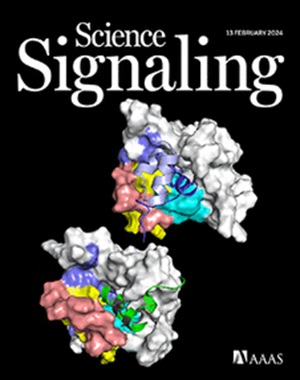膜内蛋白酶SPPL2b及其底物的研究:功能和疾病意义
IF 6.6
1区 生物学
Q1 BIOCHEMISTRY & MOLECULAR BIOLOGY
引用次数: 0
摘要
专门的膜内蛋白酶,被称为iclip,通过释放细胞内结构域来调节跨膜蛋白的加工,这些结构域可以作为转录调节剂。iclip的信号肽肽酶样(SPPL)家族,特别是SPPL2b,在免疫调节、神经元功能和疾病发病机制中发挥作用。在大脑中,SPPL2b主要定位于神经元和小胶质细胞的质膜,在皮层和海马中含量丰富。其已知底物调节神经元生长、炎症和突触功能,并且在阿尔茨海默病患者死后脑组织中发现SPPL2b数量增加。在这篇综述中,我们讨论了SPPL2b目前已知的作用、它的底物和它的疾病意义。了解SPPL2b切割底物的下游作用将为SPPL2b对细胞稳态和疾病的影响提供更清晰的见解,可能导致新的治疗策略。本文章由计算机程序翻译,如有差异,请以英文原文为准。
Insights into the intramembrane protease SPPL2b and its substrates: Functions and disease implications
Specialized intramembrane proteases, known as iCLiPs, regulate the processing of transmembrane proteins by releasing intracellular domains, which can function as transcriptional regulators. The signal peptide peptidase–like (SPPL) family of iCLiPs, particularly SPPL2b, has roles in immune regulation, neuronal function, and disease pathogenesis. In the brain, SPPL2b localizes mainly in the plasma membrane of neurons and microglia and is abundant in the cortex and hippocampus. Its known substrates regulate neuronal growth, inflammation, and synaptic function, and increased amounts of SPPL2b have been found in postmortem brain tissue from patients with Alzheimer’s disease. In this review, we discuss the currently known roles of SPPL2b, its substrates, and its disease implications. Understanding the downstream effects of SPPL2b-cleaved substrates will provide clearer insights into the impact of SPPL2b on cellular homeostasis and disease, potentially leading to new therapeutic strategies.
求助全文
通过发布文献求助,成功后即可免费获取论文全文。
去求助
来源期刊

Science Signaling
BIOCHEMISTRY & MOLECULAR BIOLOGY-CELL BIOLOGY
CiteScore
9.50
自引率
0.00%
发文量
148
审稿时长
3-8 weeks
期刊介绍:
"Science Signaling" is a reputable, peer-reviewed journal dedicated to the exploration of cell communication mechanisms, offering a comprehensive view of the intricate processes that govern cellular regulation. This journal, published weekly online by the American Association for the Advancement of Science (AAAS), is a go-to resource for the latest research in cell signaling and its various facets.
The journal's scope encompasses a broad range of topics, including the study of signaling networks, synthetic biology, systems biology, and the application of these findings in drug discovery. It also delves into the computational and modeling aspects of regulatory pathways, providing insights into how cells communicate and respond to their environment.
In addition to publishing full-length articles that report on groundbreaking research, "Science Signaling" also features reviews that synthesize current knowledge in the field, focus articles that highlight specific areas of interest, and editor-written highlights that draw attention to particularly significant studies. This mix of content ensures that the journal serves as a valuable resource for both researchers and professionals looking to stay abreast of the latest advancements in cell communication science.
 求助内容:
求助内容: 应助结果提醒方式:
应助结果提醒方式:


